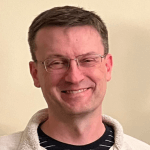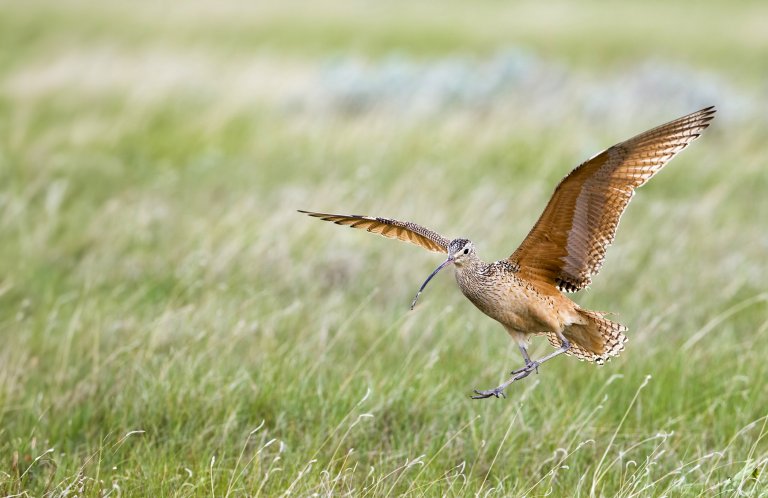Our North Stars: 30 Birds, 30 Years — Part One
Meet 30 bird species from across the Western Hemisphere that ABC has helped to conserve in the last three decades.
In the 30 years since American Bird Conservancy was founded, we and our partner groups throughout the Western Hemisphere have conserved millions of acres and protected habitat for more than 3,000 bird species.
We'd love to be able to introduce you to all 3,000+ species, but that's not in the cards for just one or two articles. Instead, allow us to present 30 special bird species that represent ABC programs and partnerships — and whose futures are looking brighter thanks to our conservation focus. These stories show that ABC's bold action for birds works: We can bring birds back from the brink, enable populations to recover, and reduce the threats they face. Many more bird species are in need of conservation action, but as these stories show, there is hope.
Each species profile includes notes on its estimated population, the population trend, habitat, and its status on the International Union for Conservation of Nature (IUCN) Red List, which range from Critically Endangered to Least Concern.
Your support, no matter the amount, helps ensure that ABC can keep the organization running efficiently for the benefit of the birds covered here. If you're not currently a Member, please consider joining the ranks of the nearly 30,000 people who help us care for birds and bird habitats throughout the Americas.
Avian Discoveries
It's not every day that a bird species is discovered or rediscovered, but it seems to happen somewhere in the world a few times per year. These three species are examples of these discoveries — and their stories illustrate how ABC is involved in projects that benefit them. The Search for Lost Birds, a collaboration between ABC, BirdLife International, and Re:wild, works to locate species that have not been recorded for a decade or more. The Blue-eyed Ground-Dove of Brazil was in that camp until its rediscovery in 2015. Now, it's the focus of a captive-breeding program that ABC supports. ABC and other partners also work to protect habitat for birds that have been discovered or rediscovered. For example, we've been involved in creating reserves in recent years for the ground-dove, the Cundinamarca Antpitta (discovered in 1989) and the Blue-throated Hillstar (discovered in 2017).
Cundinamarca Antpitta
Grallaria kaestneri
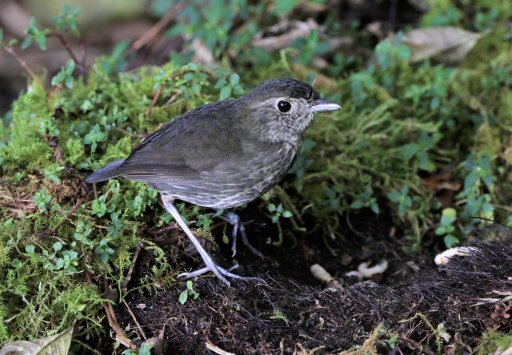
The genus name for this bird and more than 45 other antpitta species, Grallaria, is derived from a Latin word meaning “stilt-walker,” which refers to the birds' long legs. The 19th-century naturalists who named the genus, however, were not lucky enough to encounter this particular antpitta. It went undiscovered until 1989, when top world birder Peter Kaestner (now an ABC Ambassador) heard an unfamiliar bird call in a Colombian forest. He soon saw the bird, and three years later, it was officially recognized. With an olive-brown back and gray underparts streaked with white, the Cundinamarca Antpitta may not be particularly eye-catching, but it has garnered much attention due to the deforestation threatening its small range. Recently, 446 acres were purchased for the antpitta to create the Reserva Natural Refugio Tororoi by Fundación Camaná, working in partnership with the local Herrera family, and supported by ABC and direct investment funds of the Conserva Aves initiative. We also featured the species and our work to conserve it during a March 2024 ABC webinar, which is available on our YouTube channel in English and Spanish.
- Population: 330-800
- IUCN Status: Endangered
- Trend: Decreasing
- Habitat: Highland cloud forest in central Colombia
Blue-throated Hillstar
Oreotrochilus cyanolaemus

The striking Blue-throated Hillstar was discovered in 2017 in the Andes Mountains of southern Ecuador. It exists only in an ecosystem known as the páramo, which consists of alpine grasses and shrubs found from elevations of about 10,000 to 16,000 feet. An evergreen shrub with spiky leaves and small pine-cone-like orange flowers called the Chuquiragua is the hillstar's main food source, and the bird is the plant's main pollinator. Due to this interdependence, restoring patches of Chuquiragua is key to conserving the bird. Shortly after the bird's discovery, ABC and Ecuadorian partner Fundación Jocotoco began buying habitat around Cerro de Arcos, where most of the population is found. In 2020, the groups created the Cerro de Arcos Reserve and have continued to expand it. Today it covers more than 1,330 acres, and at least 300 more acres may be added within two years.
- Population: 80-110
- IUCN Status: Critically Endangered
- Trend: Decreasing
- Habitat: High-altitude grassland in Ecuador
Blue-eyed Ground-Dove
Columbina cyanopis
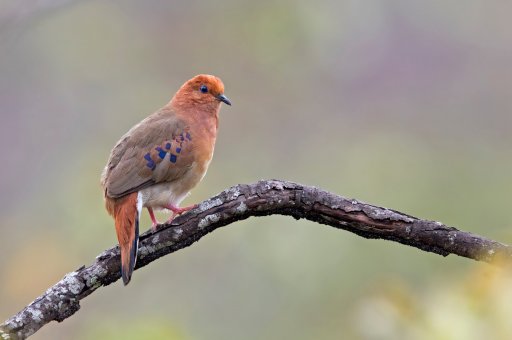
In 2015, Brazilian ornithologist Rafael Bessa was conducting field work when he heard an unfamiliar bird call. The source turned out to be the Blue-eyed Ground-Dove, a species feared extinct for 75 years. While it's not extinct, its numbers are critically low. The small, mostly cinnamon-colored dove is named for its vivid blue eyes, which match the spots dotting its wings. ABC partner SAVE Brasil leads conservation work for the species, including the creation of the 1,465-acre Blue-eyed Ground-Dove Reserve. ABC supported the reserve and its management through a grant from the Latin American Reserve Stewardship Initiative, a program of ABC and March Conservation Fund. Fledging success of wild-hatched chicks is very low, so in hopes of boosting the bird's numbers, scientists have turned to captive breeding. In the last two years, three ground-dove chicks have hatched in captivity, and the team hopes to produce more over the coming years.
- Population: 17 wild, 3 captive
- IUCN Status: Critically Endangered
- Trend: Decreasing
- Habitat: Tropical savanna of eastern Brazil
Local Specialties
Many bird species exist only in one place on Earth, where their limited ranges leave them vulnerable to significant threats within the places they call home. ABC works with partner organizations and local communities on behalf of many threatened endemic species, especially in establishing or expanding nature reserves where the birds are found. And since 2015, ABC and March Conservation Fund have worked to strengthen the internal operations of on-the-ground ABC partners that are committed to land stewardship through the Latin American Reserve Stewardship Initiative (LARSI). Three local endemic species that benefit from this work are the Marsh Antwren of Brazil, the Worthen's Sparrow of Mexico, and the Royal Cinclodes of Peru and Bolivia.
Royal Cinclodes
Cinclodes aricomae

For decades, ABC and our partners in Peru and Bolivia have been working toward the recovery of the Critically Endangered Royal Cinclodes. The dark-brown member of the furnariids family nests in tunnels dug into banks and cliff faces, and it forages in moss mostly found underneath shrub-like evergreens in the genus Polylepis. Since 2002, ABC has directly supported our Peru partner Asociación Ecosistemas Andinos (ECOAN) in planting nearly 1.4 million native trees to restore 1,700 acres of Polylepis woodlands in the Vilcanota mountain range. Similarly, in Bolivia, ABC, Asociación Armonía, and Instituto de Ecología have planted thousands of trees in the bird's range. More signs of hope: Local communities have established protected areas in Peru covering 21,000 acres, and ABC and ECOAN are working on a new 13,000-acre reserve with the community of Quelcanca. And ECOAN censuses from 2002 to 2023 have found increases of some cinclodes populations in managed forests within protected areas.
- Population: Fewer than 250
- IUCN Status: Critically Endangered
- Trend: Decreasing
- Habitat: High-altitude woodlands and montane scrub in Peru and Bolivia
Worthen's Sparrow
Spizella wortheni
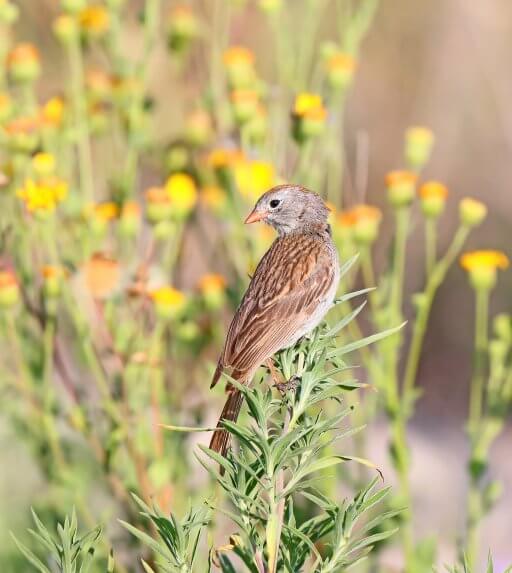
The Worthen's Sparrow, which is found only in arid open lands of Mexico's Chihuahuan Desert, is closely related to several sparrows found in the United States, including Field, Chipping, and Black-chinned. In fact, it looks similar to the Field Sparrow, and its song sounds like the Chipping Sparrow's. But unlike those more common and widespread birds, the Worthen's is restricted to a limited range. Habitat loss due to potato farming and overgrazing by livestock are primary threats. The species also relies on rainfall for its breeding cycle, and therefore it is further at risk due to altered rainfall patterns caused by climate change. Since 2007, ABC, Southern Wings, the Rio Grande Joint Venture, and our partner in Mexico, Pronatura Noreste, have been working to conserve the sparrow's habitat in El Tokio Grassland Priority Conservation Area; to date, more than 140,000 acres have been protected through acquisition or enrolled in conservation agreements.
- Population: 250-1,000
- IUCN Status: Endangered
- Trend: Decreasing
- Habitat: Shrubby, arid grasslands and fallow fields of Mexico
Marsh Antwren
Formicivora paludicola
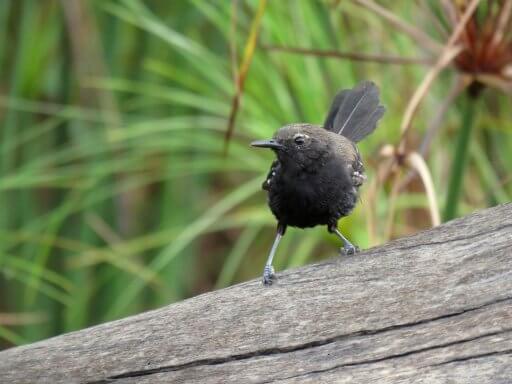
The Marsh Antwren, a long-tailed and dark-colored bird that was discovered in 2004, is the only bird species endemic to the state of São Paulo, Brazil. It lives in a few dozen small marshes at the headwaters of the Tietê and Paraíba do Sul river basins, around 30 miles east of São Paulo, the largest metropolis in South America. Habitat loss due to sand mining, housing developments, and fish farming is its primary threat. Another is an invasive grass species that encroaches on the antwren's habitat. In 2019, the municipality of Guararema established the 5,860-acre Bicudinho Wildlife Refuge after ABC supported a population survey and census of the species by our partner, SAVE Brasil. Another nonprofit, Guaranature, and municipal authorities mapped the bird's habitat and designed the refuge's boundaries. ABC is currently working to establish a second reserve for the antwren — a further sign of hope.
- Population: 150-700
- IUCN Status: Critically Endangered
- Trend: Unknown
- Habitat: Freshwater marshes in the state of São Paulo, southeastern Brazil
North American Icons
Certain bird species are, simply put, feathered celebrities. These include birds with spectacular plumages and behaviors as well as state birds and game birds. Unfortunately, some iconic species are also under threat, and ABC and our partners work to bring their populations back through a variety of methods. For example, ABC advocates for more protection for the charismatic yet declining Greater Sage-Grouse at the federal and state level. And ABC's BirdScapes and Pesticides programs benefit the Western Meadowlark, the state bird for six states. Similarly, our work with the Migratory Bird Joint Ventures (JVs) and other partners helps the Northern Bobwhite, a popular game bird and the state bird in three states.
Western Meadowlark
Sturnella neglecta

When American states were selecting their state birds, six of them — Montana, Kansas, Nebraska, North Dakota, Oregon, and Wyoming — chose the Western Meadowlark. And for good reason: It's a striking yellow-chested bird with a lovely gurgling song that is found from west-central Canada to the Great Lakes to central Mexico. Despite its large range, its population has fallen by more than 40 percent in the last 50 years. The familiar foes of habitat loss and pesticide use are primary threats. The meadowlark and other grassland species benefit from ABC's BirdScapes conservation approach, which focuses on habitats that migratory birds require. We also continue advocating for the cancellation of dangerous pesticides that threaten insect-eating birds.
- Population: 90 million
- IUCN Status: Least Concern
- Trend: Decreasing
- Habitat: Grasslands such as prairies, pastures, and abandoned fields
Northern Bobwhite
Colinus virginianus
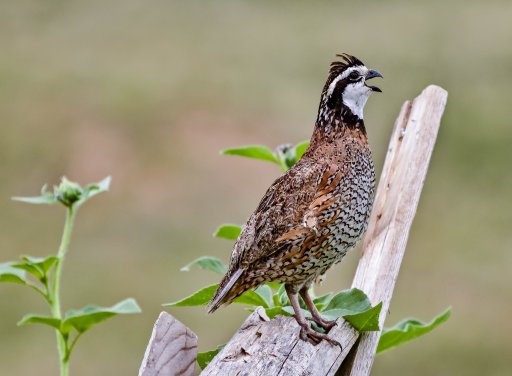
This handsome, ground-dwelling quail species is found in the eastern and southern United States and Mexico, as well as the Caribbean and a few isolated spots in the Pacific Northwest. Once a common species, the Northern Bobwhite's numbers have dropped by 85 percent in the last several decades. Habitat loss and the increasing usage of pesticides appear to be the leading reasons for the decline. In recent years, widely used neonicotinoid pesticides have taken a significant toll on the bobwhite and other grassland birds, and ABC has been leading efforts for more regulation of the chemicals. In addition, we work with landowners to restore grassland habitat through projects such as the Grassland Restoration Incentive Program and the National Bobwhite and Grassland Initiative. ABC is also advocating for measures to be included in the next Farm Bill that would help grassland species such as the bobwhite rebound.
- Population: 5.8 million
- IUCN Status: Near Threatened
- Trend: Decreasing
- Habitat: Old fields and hedgerows, native grasslands, open forests
Greater Sage-Grouse
Centrocercus urophasianus

The Greater Sage-Grouse, the largest North American grouse, has inspired humans for centuries, especially due to the male's strutting and booming mating display. Sadly, the species has not fared well in the industrial era. Its range once included 13 western states and three Canadian provinces, but now, habitat loss, energy production, overgrazing, and other factors have constricted it to 11 states and slivers of two provinces. For years, ABC's Policy team has advocated for the sage-grouse in Washington, D.C., and in western states. This year, the U.S. Bureau of Land Management proposed new management plans for the species; ABC and other conservation groups have called the agency's preferred plan inadequate. Instead, conservationists say, the agency should provide more durable, comprehensive protections for the habitat most vital to the bird. A final plan is expected soon.
- Population: 150,000
- IUCN Status: Near Threatened
- Trend: Decreasing
- Habitat: Sagebrush plains and open country in the western United States and Canada
Conservation Symbols
Condors, albatrosses, and macaws are large, gregarious, and spectacular birds that, thanks to their size, evoke awe in anyone who spots them. These three species are flagship species for conservation, especially in South America. ABC and our partners work to help these and other symbolic bird species by improving fisheries and reducing plastic waste in the oceans, protecting habitats, and strengthening habitat management through the Latin American Reserve Stewardship Initiative.
Andean Condor
Vultur gryphus

Andean Condors weigh up to 33 pounds, ranking them among the heaviest flying birds. They soar over their namesake mountains in western South America on wingspans of up to 10.5 feet. Unfortunately, their size also makes them a target for sport hunters or ranchers who mistakenly consider the birds a threat to livestock. Condors are also deliberately poisoned, develop lead poisoning from ammunition they consume when scavenging game, and can strike powerlines. To assist the species, ABC helped our partner Fundación Jocotoco acquire a 7,438-acre area in Ecuador, Chakana Reserve. It protects the majority of condors found in that country. Other reserves established by ABC and our partners where condors are present include the Red-fronted Macaw Reserve in Bolivia and the Vilcanota Reserve Network in Peru.
- Population: 10,000
- IUCN Status: Near Threatened
- Trend: Decreasing
- Habitat: Mountainous regions up to 16,000 feet in the Andes and Patagonia; coastal areas of western South America
Waved Albatross
Phoebastria irrorata
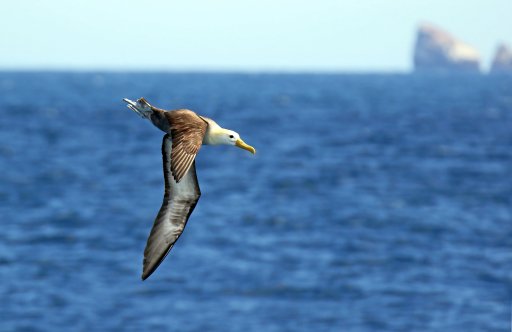
Of the 22 albatross species in the world, 15 are threatened with extinction, and one is the Waved Albatross of South America. Most of the roughly 12,000 breeding pairs nest on Española Island in the Galápagos archipelago; in addition, a handful of pairs nest on Isla de la Plata, 17 miles off the coast of Ecuador. Threats include longline fishing, which hooks birds on bait intended for fish, drowning them; climate change, which is warming the ocean where the birds feed; and floating plastic trash, which the birds mistake for food. Since 2008, ABC's Marine program has focused on several ways to help the albatross. We work with local fishers to reduce accidental bycatch in the fisheries of southwestern Ecuador, and we offer a free web-based tool that helps fisheries avoid accidentally catching seabirds.
- Population: 50,000-70,000
- IUCN Status: Critically Endangered
- Trend: Decreasing
- Habitat: Open ocean for foraging; for nesting, sparse vegetation on lava fields with scattered boulders
Blue-throated Macaw
Ara glaucogularis

The Blue-throated Macaw, one of the rarest members of the parrot family, occurs in the wild only in northeastern Bolivia. The cagebird trade and habitat loss reduced its numbers in the 1990s to 110-130 birds. Thankfully, years of conservation work by Asociación Armonía, the World Parrot Trust, Rainforest Trust, Loro Parque Fundación, the Laney Rickman Blue-throated Macaw Fund, and ABC have helped the species rebound. Trapping of the macaw was outlawed, and in 2008, ABC supported the creation of the Barba Azul Nature Reserve, the first protected area for the species. After several expansions, it's now more than 27,000 acres in size. And more recently, ABC and our partners acquired a 1,680-acre former cattle ranch that is home to a successful nest box program for the macaw. Recovery efforts have led to a wild population of about 350-450 individuals.
- Population: 350-450
- IUCN Status: Critically Endangered
- Trend: Increasing
- Habitat: Wet tropical savannas of northern Bolivia
Tiny Wonders
Hummingbirds' small size, characteristic rapid wingbeats, spectacular plumage, and various other adaptations have captivated humans for centuries. All 360-plus of the world's hummingbird species occur in the Western Hemisphere, making the family the perfect symbol for American Bird Conservancy. Unfortunately, more than 50 hummingbird species are threatened, three of which are featured here. A variety of ABC programs help conserve hummingbirds, such as our Cats Indoors and Collisions programs, our partnerships with the Alliance for Zero Extinction and other groups, as well as tree planting and other habitat restoration.
Gray-bellied Comet
Taphrolesbia griseiventris

A long-tailed, shimmering hummingbird, the Gray-bellied Comet is found in five fragmented populations on the Pacific slope of the Andes in north-central Peru. It lives in arid habitats and is a key pollinator of desert cacti, shrubs, and trees. Habitat loss and fires are its primary threats. For decades, ABC has supported tree-planting projects that have put 7 million trees in the ground in 15 countries. With our longtime partner in Peru, Asociación Ecosistemas Andinos (ECOAN), we've planted more than 3 million trees, some of which provide food and habitat for the comet. For example, in 2022, we exceeded 100,000 trees planted for the species in the Río Chonta Valley. Also in 2022, ABC launched our Preventing Bird Extinctions Fund, which earmarks donations to programs that help save species at the top of ABC's bird conservation framework, including the comet. This special bird deserves our attention in multiple ways, which we're more than happy to provide.
- Population: 250-1,000
- IUCN Status: Endangered
- Trend: Decreasing
- Habitat: Semi-arid, shrubby slopes and canyons in northern Peru
Short-crested Coquette
Lophornis brachylophus
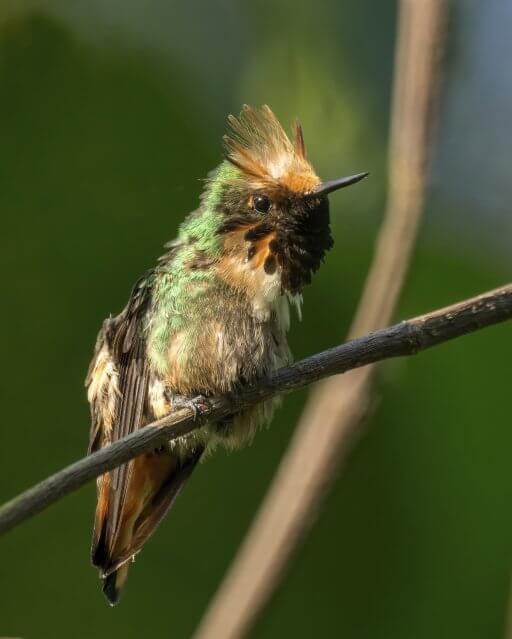
The rare and spectacular Short-crested Coquette inhabits an area of about 44 square miles in the southern Mexican state of Guerrero. The bird, which was declared a full species in the early 1990s, is tiny — less than 3 inches long. And at fewer than 1,000 individuals, its population is also tiny. It lives in part of the Sierra de Atoyac, which is recognized as an Important Bird Area and an Alliance for Zero Extinction site. ABC has been working on the coquette's conservation for the last five years, along with the Universidad Autónoma de Guerrero (Autonomous University of Guerrero), local communities, and Mexico's National Commission of Protected Natural Areas (Comisión Nacional de Áreas Naturales Protegidas, or CONANP). This year, the partners announced six new protected areas, totaling nearly 22,000 acres, are being established for the bird. The species and its home mountain range have also been the subject of a recent 20-minute documentary and a one-hour ABC webinar.
- Population: 250-1,000
- IUCN Status: Critically Endangered
- Trend: Decreasing
- Habitat: Mountainous forest in western Mexico
Rufous Hummingbird
Selasphorus rufus
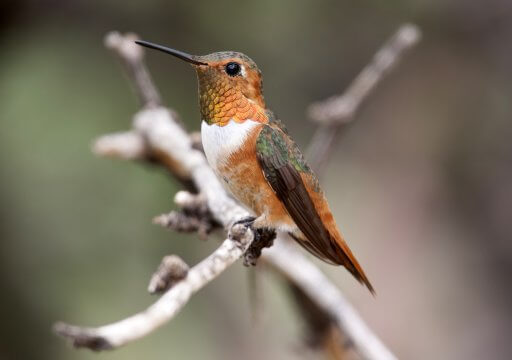
The Rufous Hummingbird, a familiar bird to North American birders, breeds from southern Alaska south to Oregon and Idaho and winters in the southeastern and southwestern United States and western Mexico. The species makes one of the longest migration journeys among the world's birds, as measured by body size. The 3-inch-long bird flies roughly 3,900 miles one way from Alaska to Mexico. It also wanders more than most hummingbirds; in the last few years, it has been reported as far east as Newfoundland. The species is still common, but habitat loss, climate change, and other threats prompted the International Union for Conservation of Nature in 2018 to reclassify it as Near Threatened. The birds are easy prey for outdoor cats, and they collide with windows and other human-made obstacles. ABC's Cats Indoors and Glass Collisions programs both offer solutions to these problems.
- Population: 19 million
- IUCN Status: Near Threatened
- Trend: Decreasing
- Habitat: Breeds in northwestern U.S. and Canadian forests; winters in Mexican highlands and southeastern U.S.
Learn about the rest of ABC's 30 “North Stars” here.
We are deeply grateful to all of the many supporters who have ensured a future for these 30 special bird species. We couldn't have done it without you!
This article originally appeared in the Fall 2024 issue of Bird Conservation, the Member magazine of American Bird Conservancy. Learn more about the benefits of becoming an ABC Member and join today.





































